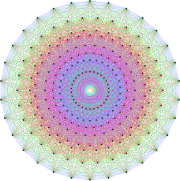| Lie groups and Lie algebras | ||||
|---|---|---|---|---|
 | ||||
Classical groups
|
||||
Simple Lie groups
|
||||
| Other Lie groups | ||||
| Lie algebras | ||||
| Semisimple Lie algebra | ||||
| Representation theory | ||||
| Lie groups in physics | ||||
| Scientists | ||||
In algebra, a simple Lie algebra is a Lie algebra that is non-abelian and contains no nonzero proper ideals. The classification of real simple Lie algebras is one of the major achievements of Wilhelm Killing and Élie Cartan.
A direct sum of simple Lie algebras is called a semisimple Lie algebra.
A simple Lie group is a connected Lie group whose Lie algebra is simple.
Complex simple Lie algebras
Main article: root systemA finite-dimensional simple complex Lie algebra is isomorphic to either of the following: , , (classical Lie algebras) or one of the five exceptional Lie algebras.
To each finite-dimensional complex semisimple Lie algebra , there exists a corresponding diagram (called the Dynkin diagram) where the nodes denote the simple roots, the nodes are jointed (or not jointed) by a number of lines depending on the angles between the simple roots and the arrows are put to indicate whether the roots are longer or shorter. The Dynkin diagram of is connected if and only if is simple. All possible connected Dynkin diagrams are the following:
where n is the number of the nodes (the simple roots). The correspondence of the diagrams and complex simple Lie algebras is as follows:
- (An)
- (Bn)
- (Cn)
- (Dn)
- The rest, exceptional Lie algebras.
Real simple Lie algebras
If is a finite-dimensional real simple Lie algebra, its complexification is either (1) simple or (2) a product of a simple complex Lie algebra and its conjugate. For example, the complexification of thought of as a real Lie algebra is . Thus, a real simple Lie algebra can be classified by the classification of complex simple Lie algebras and some additional information. This can be done by Satake diagrams that generalize Dynkin diagrams. See also Table of Lie groups#Real Lie algebras for a partial list of real simple Lie algebras.
Notes
- Fulton & Harris 1991, Theorem 9.26.
- ^ Fulton & Harris 1991, § 21.1.
- Fulton & Harris 1991, § 21.2.
See also
References
- Fulton, William; Harris, Joe (1991). Representation theory. A first course. Graduate Texts in Mathematics, Readings in Mathematics. Vol. 129. New York: Springer-Verlag. doi:10.1007/978-1-4612-0979-9. ISBN 978-0-387-97495-8. MR 1153249. OCLC 246650103.
- Jacobson, Nathan, Lie algebras, Republication of the 1962 original. Dover Publications, Inc., New York, 1979. ISBN 0-486-63832-4; Chapter X considers a classification of simple Lie algebras over a field of characteristic zero.
- "Lie algebra, semi-simple", Encyclopedia of Mathematics, EMS Press, 2001
- Simple Lie algebra at the nLab
 ,
,  ,
,  (
( , there exists a corresponding diagram (called the
, there exists a corresponding diagram (called the 




 is a finite-dimensional real simple Lie algebra, its complexification is either (1) simple or (2) a product of a simple complex Lie algebra and its
is a finite-dimensional real simple Lie algebra, its complexification is either (1) simple or (2) a product of a simple complex Lie algebra and its  . Thus, a real simple Lie algebra can be classified by the classification of complex simple Lie algebras and some additional information. This can be done by
. Thus, a real simple Lie algebra can be classified by the classification of complex simple Lie algebras and some additional information. This can be done by